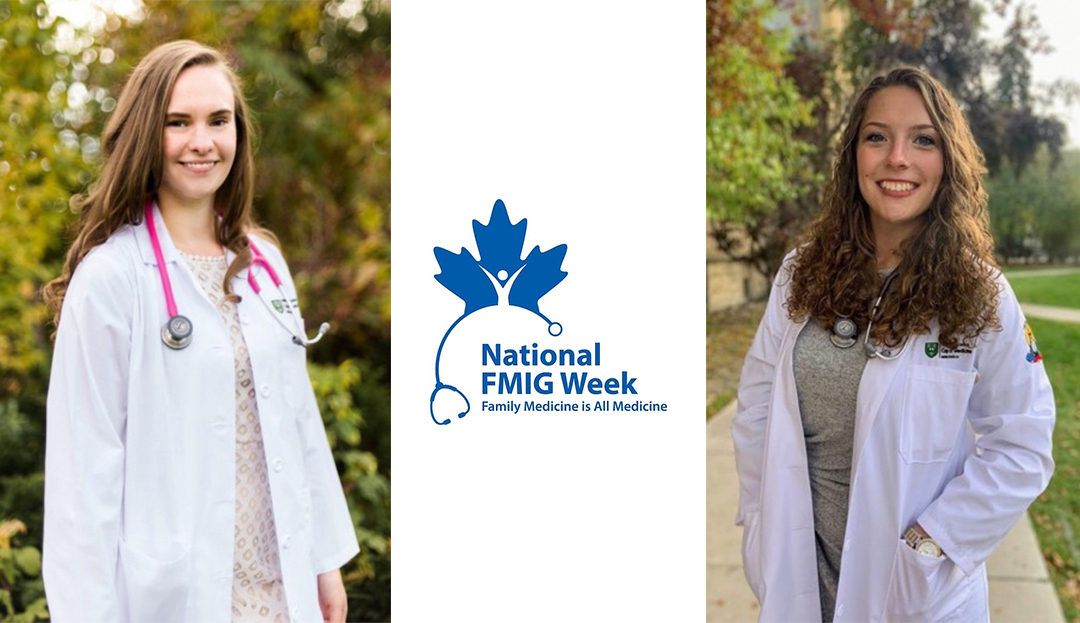
What we learned during Family Medicine Interest Group Week
During Family Medicine Interest Group Week (Feb. 8-12), medical students Jessica and Shannon write about why they're interested in family medicine and what the specialty entails.
By Jessica Froehlich and Shannon HaughianA 16-year-old female who is in a new relationship and wishing to access contraception. A 57-year-old male who recently immigrated to Canada and is presenting with hypertension. A 92-year-old male who is living independently in a retirement residence and reports trouble sleeping after recently losing his wife of 68 years. A three-year-old female who has a three-week history of fatigue, a low-grade fever, leg pain, and petechiae on her chest and face.
This is one of many reasons that we love family medicine — a broad spectrum of comprehensive care and patient-continuity from cradle to grave. And there are many students who feel the same!
This past week medical students across Canada participated in Family Medicine Interest Group Week. They hosted discussions with students and family physicians about comprehensive care, physician advocacy, enhanced skills, patient-centered care, and more.
We found the talks about physician advocacy and comprehensive care especially exemplified our passions about family medicine. Good primary care requires a broad knowledge base where physicians can act as a starting point for those accessing care, and a connecting point within our complex medical systems.
Family physicians also have the special opportunity to be able to advocate for their patients and their communities at the micro, meso, and macro levels.

One of the ways that family medicine can embody the themes of comprehensive care and advocacy is through the Patient’s Medical Home. Integrating this framework into a primary care setting has been shown to improve access to care, increase patient satisfaction, reduce ER visits, and cut down on costs.
One way of looking at the Patient’s Medical Home is to think of a “one-stop shop.” When a patient visits their family doctor, they will also have access to a variety of health professionals that are pertinent to their care.
This may include specialists, nurses, social workers, therapists, pharmacists, and other clinical and non-clinical providers. In many cases, these allied health care providers can be found in the same building, same community, or simply linked to that family practice.
Through this framework, the patient will have access to care that is continuous, comprehensive, and more efficient. The framework also has positive implications for physicians because it increases their ability to provide effective care and grants them access to a full range of supports and services for their patients. This helps the primary care physician to offer comprehensive, patient-centered care in a way that maximizes time and resources, while preventing patients from falling through the cracks of our health systems.
There are so many aspects of family medicine that get us as students excited for our future careers! One of the greatest privileges of caring for people as a family doctor is being there for the milestone moments- the births and babies, the diagnosis of a new disease, the struggles and triumphs of a mental health journey, or the death of a loved one.
But there is also something to be said about the value of the mundane — trending a blood pressure from appointment to appointment, initiating conversations about diet or smoking cessation, tracking pediatric milestones, and listening to a heartbeat.
Each of these day-to-day tasks are an opportunity for strengthening connection and your physician-patient trust, or as Dr. Danielle Martin puts it, “investment in the ‘relationship bank’ that you may well need to withdraw from in the future.”
We may not give these tasks much thought until one day the cumulative effects of these small actions that build over time provide a foundation of trust and meaningful relationship for a patient who has a sudden life-altering experience.
Family doctors specialize in relationships, be it with individual patients in the confidence of the exam room or reaching beyond the white clinic walls to improve the health of entire communities.
In celebration of Family Medicine Interest Group Week, we have combined some of our most helpful resources to help YOU learn more about family medicine and primary care. Take a look!
Stories and Opinions
- The Surprising Lives of Small-Town Doctors, Paul Dhillon
- Better Now: Six Big Ideas to Improve Health Care for All Canadians, Dr. Danielle Martin
- Northern Exposure Podcast host interviews with Canadian family doctors including Dr. Michael Kirlew, Dr. Sandy Shamon, Dr. James Beecroft, Dr. Jennifer Rycroft, Dr. Courtney Howard, and Dr. Marcus Greatheart
- Canadian Family Physician
Toolkits and Clinical Resources
- Poverty: A Clinical Tool for Primary Care Providers (SK)
- Patient’s Medical Home
- Peds Cases Podcast
- The Hub, Family Medicine
- Canadian Family Physician
- UBC: Addictions Care and Treatment Online Course
- UBC: Gender-Affirming Primary Care
- UBC: HIV Testing in Primary Care
- UBC: Pearls for Immunization Practice
- General Practice Service Committee
Social Media
- This is Family Medicine Campaign
- USaskFamilyMed (Instagram and Facebook)
- Saskatoon Family Med Residents
- U of S Family Medicine Club
Jessica is a third-year medical student and the Family Medicine Club Co-President 2019-20. Shannon is a second year medical student and the Family Medicine Club Co-President 2020-21.
